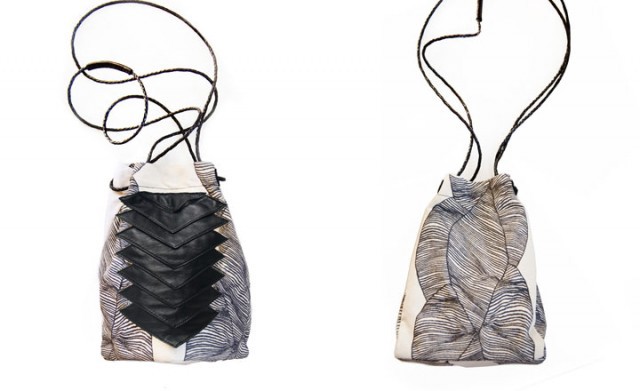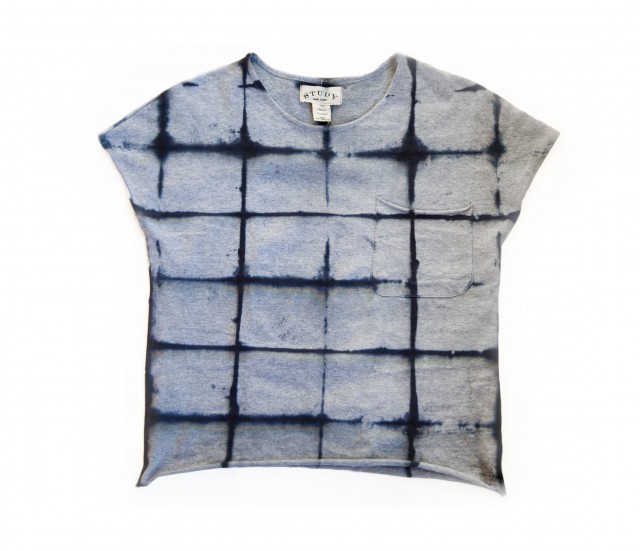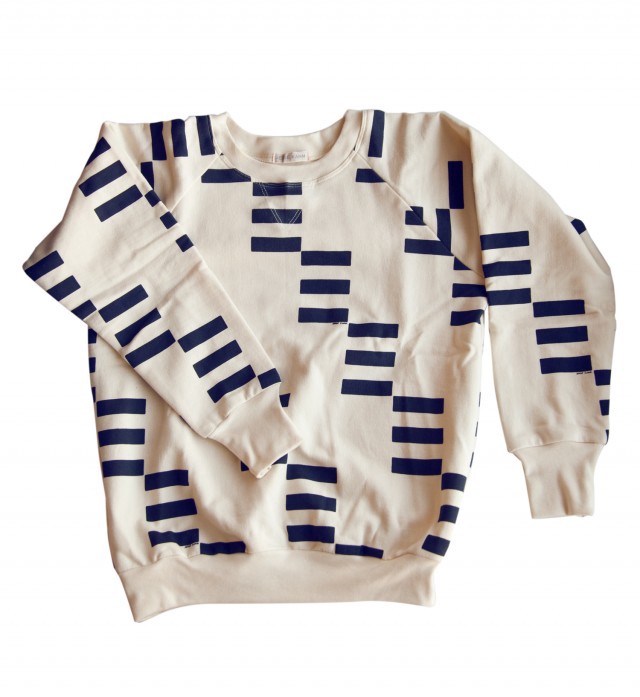Why Buying From Emerging Fashion Designers Costs More Money (and Why That’s Okay)
by Erica Cerulo

When my business partner Claire and I launched our website Of a Kind, where we sell limited-edition pieces from emerging designers and tell their stories [Ed.: we interviewed them last year!], one of the questions that our cohort asked us time and time again — and, honestly, something we frequently asked ourselves — was, “Why is this stuff so ‘spensive?!” We long to be in the fiscal position for everything in our closets to be, well, special, but we’re not there yet, and frankly we get excited about $80 boots. Though we do try to avoid buying from mass-retailers who are blatantly single-white-femaling designers we aim to support, we do shop at the Gap, love ourselves a good Target collab, and get all psyched when Madewell picks up one of the up-and-comers we’ve featured.
But we’re here to make a case that you should — at least some of the time! — buy something that’s a little more expensive. Like, $200 expensive! And not because it bears some logo of Italian pedigree or because it hung on the wrist of Rachel Bilson, but because it’s worth having a few quality things in your wardrobe that you want to hold onto for years and years. An investment piece doesn’t have to be a black blazer — it can be a super-sick ring made by a baller emerging designer who is all about craftsmanship and somehow manages to keep those creative juices flowing while running a business that involves mind-numbing things like bookkeeping, package-tracking, and invoicing. For me, it’s a pair of custom Lulu Frost earrings that I picked up from the designer Lisa Salzer herself at her apartment (!!!) and full-blown ridiculous Alexander Wang peep-toe booties from his first shoe collection — both scored back before we started the bizness.
It’s legit to look at a hang tag on some design and think, “Really?!” We still do so when we’re flipping through lookbooks and line sheets, trying to determine what pieces should make their way onto our homepage. But we’re here to explain the costs in hopes of validating the line item on your Visa bill. As Fiona Thomas of the classically cool clothing company Thomas Sires (their shirt is pictured above) explains, “We’re not charging a price because we’re making some crazy profit. We’re charging what we have to charge in order not to blatantly give it away.” Here’s why you pay more for such goodness, and why you should feel awesome about doing so.

1) The people behind said wares live in neighborhoods like yours and work with factories that treat people like people.
The designers behind the lines we feature on Of a Kind work from their homes in places like Clinton Hill in Brooklyn with their assistants (okay, dogs), or from no-frills studios in Highland Park in L.A. or Chicago’s West Loop. And they need to make an income that allows them to live in those cities and buy the requisite amount of Trader Joe’s yogurt and $9 wine.
A lot of them — especially those in the accessories realm — make pieces by hand, which limits productivity in a very real way: How many necklaces can one girl make in an hour, really? If they don’t produce themselves, they likely work with local factories that employ people who also have to earn a living that holds up in a major metropolitan area. Big duh here: made-in-America is a big deal — and a pursuit worth supporting when you can, because it has a very real impact on all our day-to-day lives. Hillary Taymour, the designer behind the slick handbag line Collina Strada (above), explains, “Deindustrialization is a huge problem we face, and it continues to grow out of control. Purchasing USA-manufactured goods can help reverse this.” But making that decision to manufacture locally isn’t a cheap one: in Hillary’s case, labor costs are $20 to $80 more per bag vs. going overseas.
We all know what the mega-producer, windowless-factory side of things can look like — we were kids during that whole Kathie Lee and Nike debacle, and read the Foxconn coverage on our iPhones. That’s hardly to say that there’s a production horror story for every denim shirt in your closet, but there’s a lot less room for error (and exploitation) when you know the person conceptualizing a dress is also going to the factory herself in Midtown Manhattan.

2) Nice materials are pricier.
No one in the history of anything has ever described rayon as “luxe.” Not once. Same goes for PVC, polyurethane, viscose, acrylic, and all sorts of other cheap materials that hold up for approximately half a spin cycle. And not to get all cost-per-wear on you, but if a pair of patterned pants are going to look like Ke$ha vomit after two nights out, suddenly $59 is expensive. Silk, leather, cashmere, however? That shit sounds fancy for a reason. It’s built to last.
Oh, and: organic or sustainable anything is pricier than the regular stuff: Tara St. James, who works in eco and fair-trade fabrics for her line Study (above), says, “An organic cotton shirting fabric costs about 20% more than a similar non-organic shirting — for example, I’ll pay between $4 and $5 a yard for a shirting depending on quality and country of origin, when I could get a standard cotton for $2 to $3. Once you get into the hand-woven or fair-trade, it’s pretty much up there in luxury-fabric pricing. In my experience, the difference between hand-woven and machine-woven for similar textiles can be about 30 to 40%. Because fair-trade manufacturers work on a much smaller scale than large production houses, their output is smaller, so cost is generally between 20 and 40% higher, but that really depends on the type of product.”

And all that is just for materials you can buy off-the-rack, so to speak. If a designer wants something custom-printed with a motif she’s dreamed up herself — something that makes the thing ultra-special — that’s a whole other story that Jesse Kamm (above), who has a cultish namesake line, is game to tell. “I come from a printmaking background and was hand-printing everything myself. When my son was born, I decided to outsource some aspects of my business because I wear so many hats. I found a place in California to do my printing, but it was so expensive. After I create the design, there’s a $300 to $500 setup fee just to get screen made. Sampling is a $75 setup plus a $35 per-color fee and then $5 per yard of fabric you have printed. If a dress takes two yards of fabric, then the print is $10 — and that’s not including the fabric itself or the sewing costs, tags, and whatnot,” she explains. “I visited a fabric supplier who said, ‘Jesse, why is your printing so expensive? We do ours overseas. They don’t have the EPA overseas.’ It was profound. So what you’re not factoring in is the cost on the environment — which will come back to get you. It was so much cheaper that I had to think, ‘Is this that important to me?’ Then I was like, ‘WHAT ARE YOU THINKING? This is all that matters.’” When manufacturing locally, those environmental costs have to be offset at the very least — you can’t just go dumping chemicals in the Gowanus in 2012.
3) There’s this thing called scale.
If you buy a shit-ton of anything, it’s cheaper — see: Sam’s Club, beer by the keg. And when you can buy up all of the denim that a supplier makes (see: Uniqlo), you’re in a much better position to negotiate on price than if you are in the market for 50 yards.
In fact, the disparity can be so great that it can seem borderline insane. “T-shirt fabric can be really expensive for us, which would surprise someone who’s producing on a really large scale,” notes Fiona Thomas of Thomas Sires. “But to order something like 300 yards, we’d need to be selling in two department stores — which is much bigger than where we are now.” That is, if the fabric is a possibility to begin with: “The minimum order for a lot of fabrics is out of reach to a small company,” Fiona’s business partner Allison Sires adds. “Assuming the mill does small orders, a 30% per yard surcharge is common.”
That’s the math ‘n business side of things. Relevant to your interests is the fact that if there are a million units of a floral dress out there, the odds are significantly higher that you’ll bump into some shiny-haired, Flywheel-assed chick wearing it than if your dress is just one of 100. (Okay, I guess that’s math, too.)
4) The designers care. So much.
Caring takes time, and time is money — that’s what people say. An unwillingness to accept fabric flaws or an insistence upon casting a brass cuff until it is just right means that there are costs that contribute to the finished product that you can’t exactly see when you’re squinting at a price tag. (To say nothing of marketing, PR, insurance, rent, internet, and all kinds of other basic expenses that fall under “The Cost of Having a Business.”) This sort of dedication to making things that people will love and hold onto means that every creation is personal and is infused with PRIDE of the sort that Tim Riggins could get behind.
Erica Cerulo co-founded Of a Kind with her friend Claire Mazur — they still love each other because they don’t see each other on weekends. Before she did that, she was an editor at Details and Lucky.